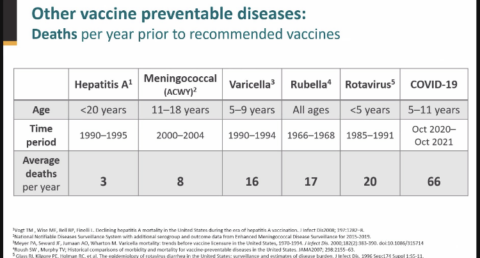A common strategy for those who wish to minimize the impact of COVID-19 on children and young people is to claim that only those with underlying conditions die from the virus. As such, it is worthwhile to explore the veracity of this claim, to examine the underlying conditions that endanger children, and to consider the implications of these findings. Information on this topic comes from two studies, one by McCormick et al. that examined 112 deceased people under age 21 years, and another by Bixler et al. that examined 121 deaths in this age group.
What percentage of deaths occur in healthy young people?
The study by McCormick et al. found that 86% of decedents had at least one underlying condition, while the study by Bixler et al found that 75% of decedents had an underlying condition. Overall, 46 out of 233 (20%) young people who died in these studies had no underlying conditions. Considering the base rate, specifically that about 75% of children are healthy, this means the risk of death to any individual healthy child is exceedingly low. No one knows the exactly number of infected children, but a ballpark estimate is that fewer than 1 in 100,000 healthy children who contract COVID-19 will die from it.
Which are the risk factors for severe disease and death in young people?
The study by McCormick et al. found that found that obesity (42%), asthma (29%), and developmental disorders (22%) were most common underlying conditions in deceased young people. The study by Bixler et all found that asthma (28%), obesity (27%), neurologic and developmental conditions (22%), and cardiovascular conditions (18%) were the most common underlying conditions in deceased young people. In both studies, about 75% of deaths occurred in Hispanic, non-Hispanic Black, and non-Hispanic American Indian/Alaskan Native persons. Another study found that, obesity, type 1 diabetes and cardiac/circulatory congenital anomalies are risk factors for severe COVID-19 illness, as is prematurity for children younger than 2 years-old.
This means the risk for healthy young people is very low, but not zero
It is clear that certain common underlying conditions pose a significant risk for death from COVID-19 for young people. However, the risk of death for healthy children is not zero. As millions of children have contracted COVID-19, rare risks have added up. According to the CDC’s COVID data tracker, 805 children younger than 18 years have died of COVID-19 thus far. If 20% of decedents were healthy, this means that around 161 healthy children have died of COVID-19 in the USA. 161 dead children isn’t nothing – at least I feel that way. It’s less than the number of children who drown per year, but it’s more than the number of children who die from school shootings or bike accidents each year, as well as from other multiple other vaccine-preventable diseases before vaccines were available.

I previously argued that how COVID-19 affects children is independent of how it affects elderly people. COVID-19 isn’t necessarily benign for children just because elderly people are more endangered. Similarly, COVID-19’s potential impact on healthy children is independent of how it affects children with underlying conditions. COVID-19 isn’t necessarily benign for healthy children just because children with underlying conditions are more endangered. Healthy children have some risk of dying, and of course death is not the only bad outcome from COVID-19. Healthy children are also at risk for hospitalization, and some hospitalized children are extremely sick, needing mechanical ventilation. Other children may feel sick, some for weeks. We need to be humble about the possibility of long-term consequences we cannot currently appreciate. There have been over 5,200 cases of MIS-C. Other than being more common in Black and Hispanic children, MIS-C seems to strike children randomly. The majority of children with MIS-C spend time in the ICU and 20% need mechanical ventilation. 46 children have died of MIS-C. The vast majority of healthy children who contract COVID-19 will be fine, thankfully, but not all.
This means most children who died from covid-19 had decades of life stolen from them
The most common underlying conditions that predispose to severe outcomes, obesity and asthma, are generally not fatal childhood diseases. Despite the claims of contrarian doctors who wish to minimize COVID-19’s impact on young people, few pediatric COVID-19 deaths occurred in children with leukemia who were fated to die on a Saturday when they instead succumbed to the virus on a Friday. Most children with underlying conditions who died from COVID-19 had decades of life stolen from them.
This means all children matter and should be vaccinated against COVID-19
Happily, the vaccine can protect adolescents from these grave outcomes. A recent CDC report found that among 179 hospitalized COVID-19 patients ages 12-18 years, 173 (97%) were unvaccinated. It further found that “All 77 case-patients admitted to the intensive care unit, all 29 critically ill case-patients, and both deaths occurred among unvaccinated case-patients”. As the vaccine is 90% effective against symptomatic COVID-19 in children ages 5-11 years, I fully expect similar data will soon emerge for this age group, along with news reports of regretful parents who falsely believed the virus posed zero risk to their children. The safety of the vaccine, especially myocarditis, will also have to be tracked over time as the vaccine is rolled out to younger children. However, as myocarditis is generally less common in young children compared to teenagers, vaccine experts are cautiously optimistic it will be less of an issue for them.
Though the benefits of vaccinating healthy children are significantly less than for everyone else, they are nonetheless very real. To make an analogy, the risk of death from any individual car trip is also exceedingly low, but my kids are buckled in every time, even though seat belts have risks too. 161 healthy children would be alive today had they been vaccinated. Tens of millions of children in the US have yet to contract the virus, and the vaccine will certainly save some of their lives. I can’t believe I have to say this, but this is a good thing. The only group of children that won’t benefit from vaccination are those that can miraculously dodge the virus for the next 80 years. Though it’s often portrayed as a means to help protect society at large, the purpose of vaccinating healthy children is to primarily protect them from COVID-19. It’s just a nice bonus that this may also protect their parents and more vulnerable classmates.
This brings me to my most important point: those vulnerable classmates matter. The lives of children with underlying conditions are no less valuable and important than the lives of healthy children. They deserve to go to school and be safe. They deserve the opportunity to grow and have children of their own. I expect these children’s lives would be valued more highly if the victims were primarily healthy White children. Too often, discourse on these children tacitly treats them as expendable. The JCVI in the UK even said, “On the whole children who died had serious underlying conditions such that they may have succumbed to other winter respiratory viruses”. In other words, “Don’t feel too bad about these weak, dead kids. Some other virus was going to get them soon anyway.” This notion seems plagiarized from an anti-vaccine article, a medical textbook from 1850, or worse.
That we can identify children who have a higher risk for severe outcomes shouldn’t be used to minimize the virus and argue against vaccination in healthy children. Rather, we should recognize there are populations of vulnerable children that need extra protection, and the best way to do this is through vaccinating ourselves and all eligible children.
It’s astonishing and depressing that this is controversial.

